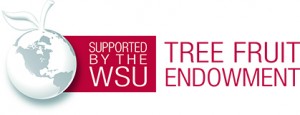Tree Fruit Research and Extension
WSU Tree Fruit Research and Extension develops and applies research-based information for sustainable tree fruit production in Washington and the world.

Fruit Matters – Tree Fruit News July 2024
In this issue of Fruit Matters, hiring a Tree Fruit Extension Educator, heat stress information, apply for USDA funding, summer events, and more.
Recent News

HIRING: WSU Tree Fruit Extension Educator
We are currently seeking a dynamic individual for a WSU Tree Fruit Extension Educator – Information and Technology Transfer position.
WSU Decision Aid System Update July 2024
The DAS apple sunburn model
Apply for USDA Funding for Food Safety Certifications
The USDA has expanded funding for specialty crop growers through the Food Safety Certification for Specialty Crops (FSCSC) program for 2024 and 2025, offering financial…
WSU Decision Aid System Update June 2024
Use DAS to consider natural enemies when controlling pests
AWN Update
The month of May saw the resumption of Mesonet station construction by the AgWeatherNet (AWN) Field Team and an expansion of our air quality network.…
Free earwigs and earwig training, Wenatchee, Yakima, Hood River, and Whatcom, 2024
Come get a free bucket of earwigs for your farm. July workshops will cover methods to mass-collect this stone fruit pest and transport them to…
Upcoming Events
17
Sep
Sep
WA 64 Pre-Harvest Field Tour South Central Washington
WSU-Prosser Roza Orchard
Get Connected
Featured Videos

Private Network Participation – the Hardware and Software
Presented by Field Meteorologist, Contezac Hill and Sean Hill, Applications Systems Analyst/Developer

WSU Weather School: Soil Moisture Sensors
A presentation by R. Troy Peters, PHD, PE, Professor/Extension Irrigation Engineer, WSU Prosser

AgWeatherNet Web Portal
AWN portal use presentation by Sean Hill, Application Systems Analyst, WSU AgWeatherNet

Technical Update for AWN
A presentation by Jonathan Contezac, Field Meteorologist at AWN Mount Vernon

AWN Overview
An overview of the WSU AgWeatherNet. AWN collects and delivers high quality, site-specific weather data and products for effective agricultural decision-support, serving irrigated agriculture in central Washington and the rest of the state (farmers, gardeners,…
Recent Publications

Evaluation of biopesticides for the control of Erwinia amylovora in Apple and Pear
In a recent study, we evaluated non-antibiotic materials for fire blight control in 8 Washington, 3 Oregon, 3 New York and 2 Pennsylvania field experiments conducted between 2013 to 2022.
Investigations of Multiple Approaches to Reduce Green Spot Incidence in ‘WA 38’ Apple
A pre-harvest apple (Malus × domestica Borkh.) disorder named “green spot” (GS) was recently identified on ‘WA 38’ apples. Previous work indicated a tentative association between GS and fruit mineral imbalance, and an influence of…

Soil Health Indicators for Central Washington Orchards
To help growers in Central Washington orchards, Washington State University scientists demonstrated that all soil health indicators should include measurements of water availability and root health in addition to standard fertility indicators to meet stakeholder…

Field scale application of Brassica seed meal and anaerobic soil disinfestation for the control of apple replant disease.
Study published June 2021 in Applied Soil Ecology shows potential of anaerobic soil disinfestation and biorenovation with mustard meals for mitigation of replant disease.

Towards rapid detection and mapping of powdery mildew in apple orchards
Chandel, Khot, Sallato Dec 2020. Powdery mildew (PM) in apples is a critical fungal disease that adversely affects yield and fruit quality. Conventional PM identification techniques are laborious. This study evaluated the suitability of non-destructive…
